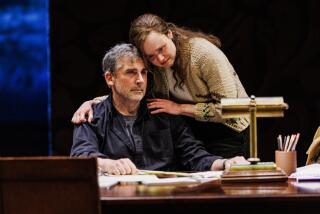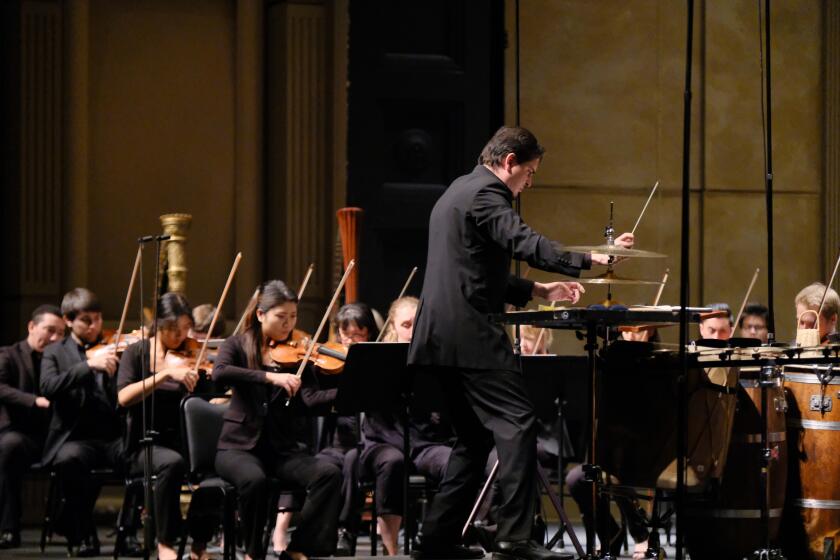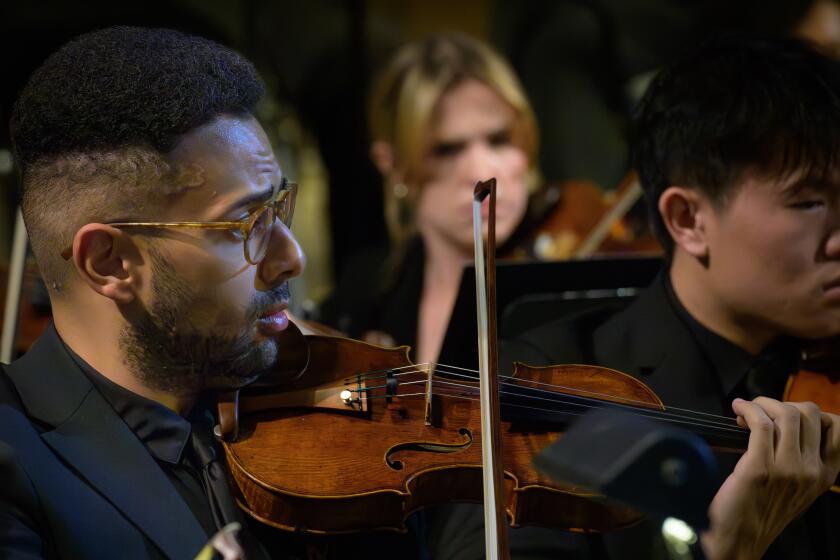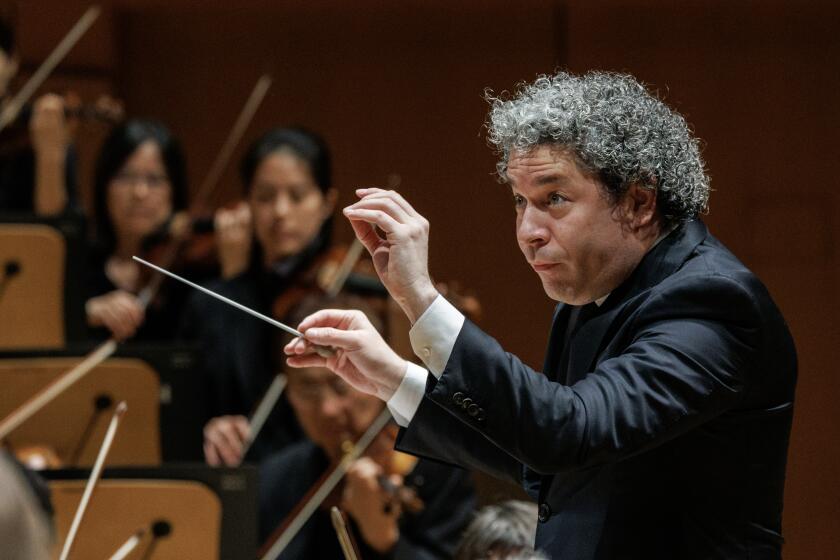A Musical Work of Little Note
Now that the proud civic moment of unveiling the third and final public-art piece for the Pond of Anaheim is behind us, it’s time for a reckoning.
The phrase “last but not least” is not the one that comes to mind. “Musical Gateway,” which streams above the east entrance of the arena, is homely and amateurish, especially as contrasted with Nam June Paik’s “Video Arch,” installed at the south entrance of the arena in 1993.
Granted, Paik, an internationally known video artist, has been working in his chosen medium for decades. He has made more complexly inventive work than this $175,000 piece (funded, as were all of the Pond’s artworks, by a percentage of proceeds from construction bonds). But “Video Arch” is a memorable work that is ideally suited to its site.
A bank of 106 monitors arranged in an arch formation flashes computerized patterns of bright-colored imagery. The impermanent, fragmentary quality and fast pace of the imagery are reminiscent of televised sports.
By taking an architectural form associated since ancient Roman times with military triumph and civic stability and giving it a deliberately unstable visual format, Paik slyly shakes up the archway’s traditional values--no small feat in the distinctly Old Guard city of Anaheim.
“Video Arch” is celebratory in a friendly, welcoming way (because of its ample but not overbearing height) even while embodying dislocation and change. It can engage a visitor fleetingly as a rush of moving color or serve as a mesmerizing focus in the familiar manner of TV. Ultimately, it makes a case for the compelling nature of structured movement--a key metaphor for spectator sports.
Conversely, while the three-person team that developed “Musical Gateway” was attempting a novel type of project (a viewer-interactive piece combining aural and visual qualities) they failed to locate a compelling format that would resonate in a sports arena.
The auditory aspect of the piece is its saving grace. Stephen Stucky, new-music advisor for the Los Angeles Philharmonic and a respected composer nationally, devised four percussive “sound environments” that can be heard--singly or together--by pressing arcade-game-style buttons mounted low on the wall.
The background music that is familiar to most people is the bland pop rendition that plays in shopping malls. Stucky’s ambient gong and bell sounds constitute a wholly different universe, emphasizing the abstract qualities of sound rather than familiar tunes. Although one could wish for more complex or original scoring, this music is pleasing to most ears and clearly audible without being distracting to chatting visitors. At the same time, the push-buttons give the piece a toy-like appeal.
But the visual part of the piece--four undulating “tracks” of abstract sculptural elements extending across the ceiling--seems extraneous. This clunky attempt at ornament seems tacked onto the blocky entryway in the hapless manner of prom decorations in a gym.
Artist Nancy Mooslin (who enlisted the help of fellow artist Sandra Rowe) has attempted to translate defining aspects of Stucky’s music into specific shapes and colors, a curiously self-limiting task.
But the only clearly “musical” quality of the piece is its repetition; from the viewer’s perspective, it’s just a bunch of bland shapes devoid of the metaphoric resonance that infuses the more captivating forms of abstraction current today.
In a burst of multicultural pleading, the prospectus for “Musical Gateway” claims that it contains “universally meaningful symbols that transcend time and culture and can actually be found in all of the cultures and ethnic groups that have settled in Southern California and Anaheim.”
This statement is so broad as to be meaningless. It goes without saying that everybody is familiar with spirals, circles and squares; it’s the context that counts.
The tubes of colorful fiber-optic light that coincide with the musical track or tracks playing at any given moment give the piece a fun-zone quality that could have been reinforced in a much more uninhibited way by a more inventive and less rule-bound artist team.
Or perhaps the piece would have been more successful as an aural project, with few or no visual components.
Public art in Orange County is still very much on a learning curve. At the Pond, the art (which also includes “The Anamorph,” an outdoor piece by Richard Turner, Ann Preston and Michael Davis) had to be inserted into a finished building rather than planned in tandem with its design.
One thing to keep in mind is that, no matter how “public” a work of public art is--in terms of official approvals and a mass audience--it is still art, which is only as worthy as the ideas that motivate it. The public at large may be pleased with or indifferent to a piece intended as a “high-impact, fun, spirited, friendly welcome.” But an artist to reckon with needs a more devious program.
More to Read
The biggest entertainment stories
Get our big stories about Hollywood, film, television, music, arts, culture and more right in your inbox as soon as they publish.
You may occasionally receive promotional content from the Los Angeles Times.






